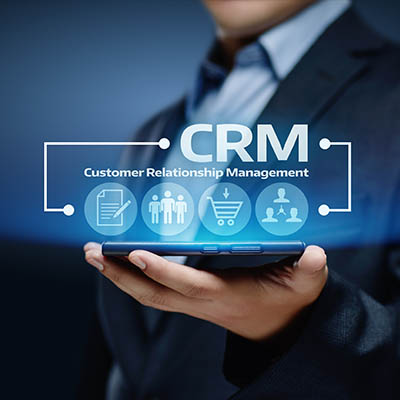Customer relationship management (CRM) is a term that refers to practices, strategies and technologies that companies use to manage and analyze customer interactions and data throughout the customer lifecycle, with the goal of improving business relationships with customers, assisting in customer retention and driving sales growth. CRM systems are designed to compile information on customers across different channels — or points of contact between the customer and the company — which could include the company’s website, telephone, live chat, direct mail, marketing materials and social media. CRM systems can also give customer-facing staff detailed information on customers’ personal information, purchase history, buying preferences and concerns.

CRM software
CRM software consolidates customer information and documents into a single CRM database so business users can more easily access and manage it. The other main functions of this software include recording various customer interactions (over email, phone calls, social media or other channels, depending on system capabilities), automating various workflow processes such as tasks, calendars and alerts, and giving managers the ability to track performance and productivity based on information logged within the system.
Common features of CRM software include:
· Marketing automation: CRM tools with marketing automation capabilities can automate repetitive tasks to enhance marketing efforts to customers at different points in the lifecycle. For example, as sales prospects come into the system, the system might automatically send them marketing materials, typically via email or social media, with the goal of turning a sales lead into a full-fledged customer.
· Sales force automation: Also known as sales force management, sales force automation is meant to prevent duplicate efforts between a salesperson and a customer. A CRM system can help achieve this by automatically tracking all contact and follow-ups between both sides.
· Contact center automation: Designed to reduce tedious aspects of a contact center agent’s job, contact center automation might include pre-recorded audio that assists in customer problem-solving and information dissemination. Various software tools that integrate with the agent’s desktop tools can handle customer requests in order to cut down the time of calls and simplify customer service processes.
· Geolocation technology, or location-based services: Some CRM systems include technology that can create geographic marketing campaigns based on customers’ physical locations, sometimes integrating with popular location-based GPS apps. Geolocation technology can also be used as a networking or contact management tool in order to find sales prospects based on location.
The CRM technology market
The four main vendors of CRM systems are Salesforce.com, Microsoft, SAP and Oracle. Other providers are popular among small- to mid-market businesses, but these four tend to be the choice of large corporations.
On-premises CRM puts the onus of administration, control, security and maintenance of the database and information on the company itself. With this approach the company purchases licenses up front instead of buying yearly subscriptions. The software resides on the company’s own servers and the user assumes the cost of any upgrades and usually requires a prolonged installation process to fully integrate a company’s data. Companies with complex CRM needs might benefit more from an on-premises deployment.
With cloud-based CRM — also known as SaaS (software-as-a-service) or on-demand CRM — data is stored on an external, remote network that employees can access anytime, anywhere there is an Internet connection, sometimes with a third-party service provider overseeing installation and maintenance. The cloud’s quick, relatively easy deployment capabilities appeals to companies with limited technological expertise or resources.
Companies might consider cloud-based CRM as a more cost-effective option. Vendors such as Salesforce.com charge by the user on a subscription basis and give the option of monthly or yearly payments.
Data security is a primary concern for companies using a cloud-based system since the company doesn’t physically control the storage and maintenance of its data. If the cloud provider goes out of business or is acquired by another company, a company’s data can be compromised or lost. Compatibility issues can also arise when data is initially migrated from a company’s previous system to the cloud. Finally, cost may be a concern, since paying subscription fees for software can be more costly than on-premises-based models.
Open source CRM programs make source code available to the public, allowing companies to make alterations with no cost to the company employing it. Open source CRM systems also allow the addition and customization of data links to social media channels, assisting companies looking to improve social CRM practices. Vendors such as SugarCRM are popular choices in the open source market.
Adoption of any of these CRM deployment methods depends on a company’s business needs, resources and goals, since each has different costs associated with it.
Trends
Traditionally, data intake practices for CRM systems have been the responsibility of sales and marketing departments as well as contact center agents. Sales and marketing teams procure leads and update the system with information throughout the customer lifecycle and contact centers gather data and revise customer history records through service call and technical support interactions.
The advent of social media and the proliferation of mobile devices has caused CRM providers to upgrade their offerings to include new features that cater to customers who use these technologies.
Social CRM refers to businesses engaging customers directly through social media platforms such as Facebook, Twitter and LinkedIn. Social media presents an open forum for customers to share experiences with a brand, whether they’re airing grievances or promoting products.
To add value to customer interactions on social media, businesses use various tools that monitor social conversations, from specific mentions of a brand to the frequency of keywords used, to determine their target audience and which platforms they use. Other tools are designed to analyze social media feedback and address customer queries and issues. Companies are interested in capturing sentiments such as a customer’s likelihood of recommending their products and the customer’s overall satisfaction in order to develop marketing and service strategies. Companies try to integrate social CRM data with other customer data obtained from sales or marketing departments in order to get a single view of the customer.
Another way in which social CRM is adding value for companies and customers is customer communities, where customers post reviews of products and can engage with other customers to troubleshoot issues or research products in real time. Customer communities can provide low-level customer service for certain kinds of problems and reduce the number of contact center calls. Customer communities can also benefit companies by providing new product ideas or feedback without requiring companies to enlist feedback groups.
Mobile CRM — or the CRM applications built for smartphones and tablets — is becoming a must-have for sales representatives and marketing professionals who want to access customer information and perform tasks when they are not physically in their offices. Mobile CRM apps take advantage of features that are unique to mobile devices, such as GPS and voice-recognition capabilities, in order to better serve customers by giving employees access to this information on the go.
CRM challenges
For all of the advancements in CRM technology, without the proper management, a CRM system can become little more than a glorified database where customer information is stored. Data sets need to be connected, distributed and organized so that users can easily access the information they need.



Comments are closed